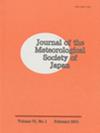Description and Attribution Analysis of the 2017 Spring Anomalous High Temperature Causing Floods in Kazakhstan
IF 1.6
4区 地球科学
Q3 METEOROLOGY & ATMOSPHERIC SCIENCES
引用次数: 5
Abstract
It is speculated that floods in many areas of the world have become more severe with global warming. This study describes the 2017 spring floods in Kazakhstan, which, with about six people dead or missing, prompted the government to call for more than 7,000 people to leave their homes. Then, based on the Climatic Research Unit (CRU), the NCEP/NCAR Reanalysis 1, and the Coupled Model Intercomparison Project 5 (CMIP5) simulations, the seasonal trends of temperature were calculated using the linear least-squares regression and the Mann–Kendall trend test. The correlation between the surface air temperature and atmospheric circulation was explored, and the attributable risk of the 2017 spring floods was evaluated using the conventional fraction of the attributable risk (FAR) method. The results indicate that the north plains of Kazakhstan had a higher (March–April) mean temperature anomaly compared to the south plains, up to 3°C, relative to the 1901-2017 average temperature. This was the primary cause of flooding in Kazakhstan. March and April were the other months with a higher increasing trend in temperature from 1901 to 2017 compared with other months. In addition, a positive anomaly of the geopotential height and air temperature for the March–April 2017 period (based on the reference period 1961-1990) was the reason for a warmer abnormal temperature in the northwest region of Kazakhstan. Finally, the FAR value was approximately equal to 1, which supported the claim of a strong anthropogenic influence on the risk of the 2017 March–April floods in Kazakhstan. The results presented provide essential information for a comprehensive understanding of the 2017 spring floods in Kazakhstan and will help government officials identify flooding situations and mitigate damage in future.2017年哈萨克斯坦春季异常高温致洪水描述及归因分析
据推测,随着全球变暖,世界许多地区的洪水已经变得更加严重。这项研究描述了2017年哈萨克斯坦春季洪水,造成约6人死亡或失踪,促使政府呼吁7000多人离开家园。然后,基于气候研究所(CRU)、NCEP/NCAR再分析1和耦合模型相互比较项目5(CMIP5)模拟,使用线性最小二乘回归和Mann-Kendall趋势检验计算了温度的季节趋势。探讨了地表气温与大气环流之间的相关性,并使用传统的归因风险分数(FAR)方法评估了2017年春季洪水的归因风险。结果表明,与南部平原相比,哈萨克斯坦北部平原的平均温度异常(3-4月)更高,相对于1901-2017年的平均温度高达3°C。这是哈萨克斯坦洪灾的主要原因。1901年至2017年,与其他月份相比,3月和4月是气温上升趋势更高的其他月份。此外,2017年3月至4月期间(基于1961年至1990年的参考期)的位势高度和气温的正异常是哈萨克斯坦西北地区异常温度升高的原因。最后,FAR值约等于1,这支持了对2017年3月至4月哈萨克斯坦洪水风险的强烈人为影响的说法。所提供的结果为全面了解哈萨克斯坦2017年春季洪水提供了重要信息,并将帮助政府官员识别洪水情况,减轻未来的损失。
本文章由计算机程序翻译,如有差异,请以英文原文为准。
求助全文
约1分钟内获得全文
求助全文
来源期刊
CiteScore
6.70
自引率
16.10%
发文量
56
审稿时长
3 months
期刊介绍:
JMSJ publishes Articles and Notes and Correspondence that report novel scientific discoveries or technical developments that advance understanding in meteorology and related sciences. The journal’s broad scope includes meteorological observations, modeling, data assimilation, analyses, global and regional climate research, satellite remote sensing, chemistry and transport, and dynamic meteorology including geophysical fluid dynamics. In particular, JMSJ welcomes papers related to Asian monsoons, climate and mesoscale models, and numerical weather forecasts. Insightful and well-structured original Review Articles that describe the advances and challenges in meteorology and related sciences are also welcome.

 求助内容:
求助内容: 应助结果提醒方式:
应助结果提醒方式:


